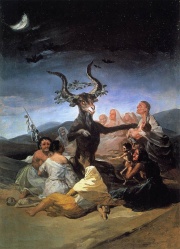Witch
From The Art and Popular Culture Encyclopedia
| Revision as of 12:38, 28 April 2021 Jahsonic (Talk | contribs) ← Previous diff |
Revision as of 13:01, 30 April 2021 Jahsonic (Talk | contribs) Next diff → |
||
| Line 1: | Line 1: | ||
| {| class="toccolours" style="float: left; margin-left: 1em; margin-right: 2em; font-size: 85%; background:#c6dbf7; color:black; width:30em; max-width: 40%;" cellspacing="5" | {| class="toccolours" style="float: left; margin-left: 1em; margin-right: 2em; font-size: 85%; background:#c6dbf7; color:black; width:30em; max-width: 40%;" cellspacing="5" | ||
| | style="text-align: left;" | | | style="text-align: left;" | | ||
| + | “All [[witchcraft]] comes from [[carnal lust]], which is in [[Insatiability of women|women insatiable]].”--''Malleus Maleficarum'' (1487) by Heinrich Kramer | ||
| + | <hr> | ||
| "The [[clergy]] has not stakes enough, the people insults, the child stones, for the unhappy being. The poet, no less a child, throws yet another stone at her, a crueller one still for a woman. Gratuitously insulting, he makes her out always [[ugly woman|old and ugly]]. The very word [[Sorceress]] or [[Witch]] calls up the image of the [[Three Witches|Weird Sisters of ''Macbeth'']]. Yet the cruel [[Witch trials in the early modern period|witch trials]] prove exactly the opposite; many perished just because they were [[beautiful woman|young and pretty]]." --''[[Satanism and Witchcraft (book)|La Sorcière]]'' (1862) by Jules Michelet | "The [[clergy]] has not stakes enough, the people insults, the child stones, for the unhappy being. The poet, no less a child, throws yet another stone at her, a crueller one still for a woman. Gratuitously insulting, he makes her out always [[ugly woman|old and ugly]]. The very word [[Sorceress]] or [[Witch]] calls up the image of the [[Three Witches|Weird Sisters of ''Macbeth'']]. Yet the cruel [[Witch trials in the early modern period|witch trials]] prove exactly the opposite; many perished just because they were [[beautiful woman|young and pretty]]." --''[[Satanism and Witchcraft (book)|La Sorcière]]'' (1862) by Jules Michelet | ||
| <hr> | <hr> | ||
Revision as of 13:01, 30 April 2021
|
“All witchcraft comes from carnal lust, which is in women insatiable.”--Malleus Maleficarum (1487) by Heinrich Kramer "The clergy has not stakes enough, the people insults, the child stones, for the unhappy being. The poet, no less a child, throws yet another stone at her, a crueller one still for a woman. Gratuitously insulting, he makes her out always old and ugly. The very word Sorceress or Witch calls up the image of the Weird Sisters of Macbeth. Yet the cruel witch trials prove exactly the opposite; many perished just because they were young and pretty." --La Sorcière (1862) by Jules Michelet "In the following pages I have endeavoured to show the witch as she really was – an evil liver: a social pest and parasite: the devotee of a loathly and obscene creed: an adept at poisoning, blackmail, and other creeping crimes: a member of a powerful secret organisation inimical to Church and State: a blasphemer in word and deed, swaying the villagers by terror and superstition: a charlatan and a quack sometimes: a bawd: an abortionist: the dark counsellor of lewd court ladies and adulterous gallants: a minister to vice and inconceivable corruption, battening upon the filth and foulest passions of the age."--The History of Witchcraft and Demonology (1926) by Montague Summers |
|
Related e |
|
Featured: |
A witch refers to a man (archaic) or a woman who practises witchcraft. It can also refer to an ugly or unpleasant woman.
Contents |
Folklore
Powers typically attributed to European witches include turning food poisonous or inedible, flying on broomsticks or pitchforks, casting spells, cursing people, making livestock ill and crops fail, and creating fear and local chaos.
Flying
In the past, it was believed that witches used a mixture of belladonna, opium poppy, and other plants, typically poisonous (such as monkshood and poison hemlock) in flying ointment they applied to help them fly to gatherings with other witches. Carlo Ginzburg and others have argued that flying ointments were preparations meant to encourage hallucinatory dreaming; a possible explanation for the inclusion of belladonna and opium poppy in flying ointments concerns the known antagonism between tropane alkaloids of belladonna (specifically scopolamine) and opiate alkaloids in the opium poppy, Papaver somniferum (specifically morphine), which produces a dream-like waking state. This antagonism was known in folk medicine, discussed in eclectic (botanical) medicine formularies The antagonism between opiates and tropanes is the original basis of the Twilight Sleep that was provided to Queen Victoria to deaden pain as well as consciousness during childbirth.
Witches in art
Renaissance
- The Four Witches
- Witch Riding Backwards on a Goat by Durer
- Hans Baldung Grien's witches
- Depart pour le Sabat by Teniers
18th century
- Witches' Sabbath (1798) by Francisco Goya
19th century
References
See also
- witch trial
- flying ointment
- Witch trials in Early Modern Europe
- Evil woman
- Sorceress
- Enchantress
- Witchcraft
- Häxan


